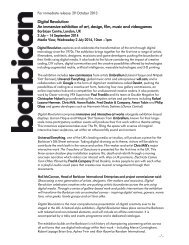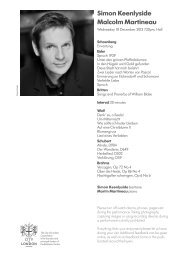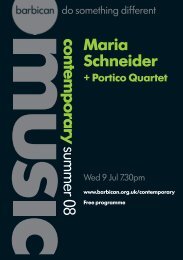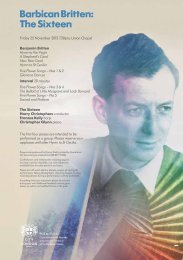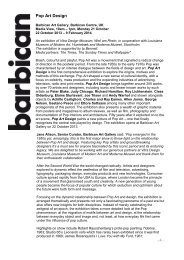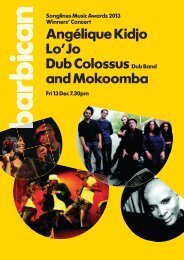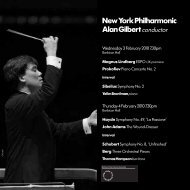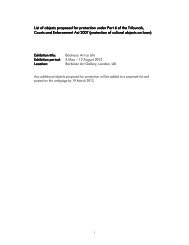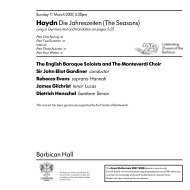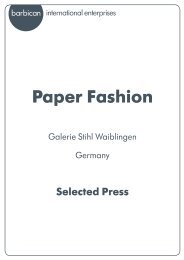Download your concert programme here - Barbican
Download your concert programme here - Barbican
Download your concert programme here - Barbican
You also want an ePaper? Increase the reach of your titles
YUMPU automatically turns print PDFs into web optimized ePapers that Google loves.
important of the Rückert-Lieder –<br />
and the one that would find most<br />
favour with the public! But it is a<br />
beguiling miniature scherzo, set<br />
in motion by a buzzing sotto voce<br />
accompaniment prompted by the<br />
apian imagery in the second verse.<br />
‘Um Mitternacht’ is the odd<br />
one out in this group, a song of<br />
stark, hieratic grandeur. After<br />
the anxious spiritual questioning<br />
of the opening verses, the final<br />
one moves from minor to major<br />
for a triumphant apotheosis as<br />
the poet surrenders his strength<br />
to God’s hands. Contrary to<br />
Mahler’s prediction, the most<br />
celebrated of the Rückert songs<br />
is ‘Ich bin der Welt abhanden<br />
gekommen’, a vocal counterpart<br />
to the famous Adagietto of the<br />
Fifth Symphony. Its text, on the<br />
familiar Romantic theme of<br />
withdrawal into a secluded world<br />
of art and nature, had a deep<br />
personal appeal to Mahler, who<br />
said of it: ‘It is my very self’. For<br />
all its rapt, timeless lyricism (the<br />
dynamics never rise above piano),<br />
the song is almost symphonically<br />
conceived, with an intricate<br />
contrapuntal interplay between<br />
voice and accompaniment.<br />
INTERVAL<br />
Arnold Schoenberg<br />
(1874–1951)<br />
Erwartung, Op. 2 No. 1<br />
Jane Grey, Op. 12 No. 1<br />
Arnold Schoenberg, the archsubverter<br />
of musical tradition,<br />
always vehemently denied that he<br />
was a revolutionary. He was, he<br />
protested, merely perpetuating<br />
the great Austro-German tradition<br />
from Bach through the Viennese<br />
Classics to Brahms, Wagner and<br />
Mahler. When his early works<br />
– above all the string sextet<br />
Verklärte Nacht, a declaration of<br />
love to his future wife, Mathilde<br />
Zemlinsky – were praised at the<br />
expense of his 12-tone music, he<br />
retorted by saying that the only<br />
differences were that his later<br />
works possessed greater clarity<br />
and economy. Schoenberg knew<br />
this was at best a half-truth. But it<br />
was always important for him to<br />
emphasise continuity rather than<br />
disruption. And in no genre is this<br />
sense of tradition more apparent<br />
than the Lied: indeed, t<strong>here</strong> is a<br />
gradual, logical progression from<br />
his early, unpublished songs to<br />
the Expressionist Stefan George<br />
cycle Das Buch der hängenden<br />
Gärten (1908–09), in which<br />
virtually all traces of conventional,<br />
structural harmony disappear.<br />
Schoenberg’s encounter with the<br />
work of the Prussian poet Richard<br />
Dehmel (1863–1920) in the mid-<br />
1890s had important creative<br />
repercussions, most obviously<br />
in Verklärte Nacht. Dehmel’s<br />
thought was heavily influenced<br />
by the philosophy of Nietzsche,<br />
and his view of regeneration and<br />
redemption through the power of<br />
the ‘inner spirit’. But t<strong>here</strong> are other<br />
strands in his poetry, including<br />
a devotion to socialist ideals, a<br />
fin de siècle eroticism and, most<br />
importantly for Schoenberg, the<br />
relationship between man and<br />
woman, which Dehmel expressed<br />
with both tenderness and with a<br />
frankness that shocked the prudish<br />
contemporary bourgeoisie.<br />
Dating from 1899 (and not<br />
to be confused with the later<br />
monodrama of the same name),<br />
‘Erwartung’ sets a Dehmel<br />
poem of sexual anticipation<br />
that foreshadows the nocturnal<br />
encounter between two lovers in<br />
Verklärte Nacht, composed shortly<br />
afterwards. Schoenberg’s musical<br />
language is still within hailing<br />
distance of Wolf’s, though the<br />
luminous, deliquescent keyboard<br />
writing sometimes threatens<br />
to dissolve tonal outlines.<br />
The impassioned, elegiac<br />
‘Jane Grey’, to verses by<br />
Heinrich Ammann on the young<br />
noblewoman who became Queen<br />
of England for just nine days<br />
in 1553, is one of two ballads<br />
Schoenberg composed in 1907 in<br />
response to a Berlin competition<br />
for new ballad settings. Neither it<br />
nor its companion, ‘Der verlorene<br />
Haufen’, won: hardly surprising<br />
given their dense, complex<br />
textures and, especially, their<br />
‘vagrant’ (Schoenberg’s term)<br />
harmonic language that often<br />
teeters on the edge of atonality.<br />
From <strong>here</strong> it is only a short step<br />
to Das Buch der hängenden<br />
Gärten, begun the same year.<br />
Alexander von Zemlinsky<br />
(1871–1942)<br />
Fünf Lieder auf Texte<br />
von Richard Dehmel –<br />
Vorspiel<br />
Ansturm<br />
Letzte Bitte<br />
Stromüber<br />
Auf See<br />
Although Alexander von<br />
Zemlinsky’s earlier works enjoyed<br />
a vogue in pre-First World War<br />
Vienna, by the 1920s he was<br />
already in eclipse. By then his style<br />
was considered too progressive for<br />
the traditionalists (whose idol was<br />
Korngold) and too conservative<br />
for the ad<strong>here</strong>nts of Schoenberg,<br />
his former pupil and brotherin-law.<br />
Zemlinsky came close<br />
to the line, but never followed<br />
Schoenberg into the brave new<br />
world of atonality, summing up<br />
4




